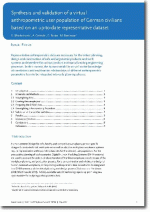- Project number: F 2396
- Institution: Federal Institute for Occupational Safety and Health (BAuA) / University Medicine Greifswald - Institute for Community Medicine
- Status: Completed Project
Description:
To enable an ergonomic workplace and machine design, the body dimensions of employees must be taken into account. This raises the question of which body dimensions can be taken by designers as a basis, to take adequate account of all employees potentially affected.
This research project aims to develop a meaningful anthropometric dataset on employed persons in Germany. Furthermore, it should be possible to adapt the dataset to future demographic changes.
2,507 3D body scans were initially carried out in a representative sample of employed persons from Mecklenburg-Western Pomerania in Germany (Study of Health in Pomerania, SHIP-Trend-1). The data obtained is compatible with those of a previous survey (SHIP-3), so that a total anthropometric sample of 4,107 body scans was used for analysis. For data protection reasons, a method was applied to convert the collected data into algorithms. The result is statistically almost identical to the collected raw data, but the participants themselves can no longer be identified.
Since the sample was taken from a specific region, the results were weighted using data from the German health interview and examination survey for adults (DEGS) conducted by the Robert Koch Institute. The algorithms developed in this project allow for reweighting with little effort as soon as data from future DEGS surveys become available. The result is a comprehensive, future-proof and meaningful anthropometric dataset for Germany.
The results of this project are vital for the design of products and work systems. The dataset makes it possible to analyse even complex interrelationships of body dimensions in three dimensions when using digital planning tools. This enables improved solutions that offer employed persons better ergonomics at work.
